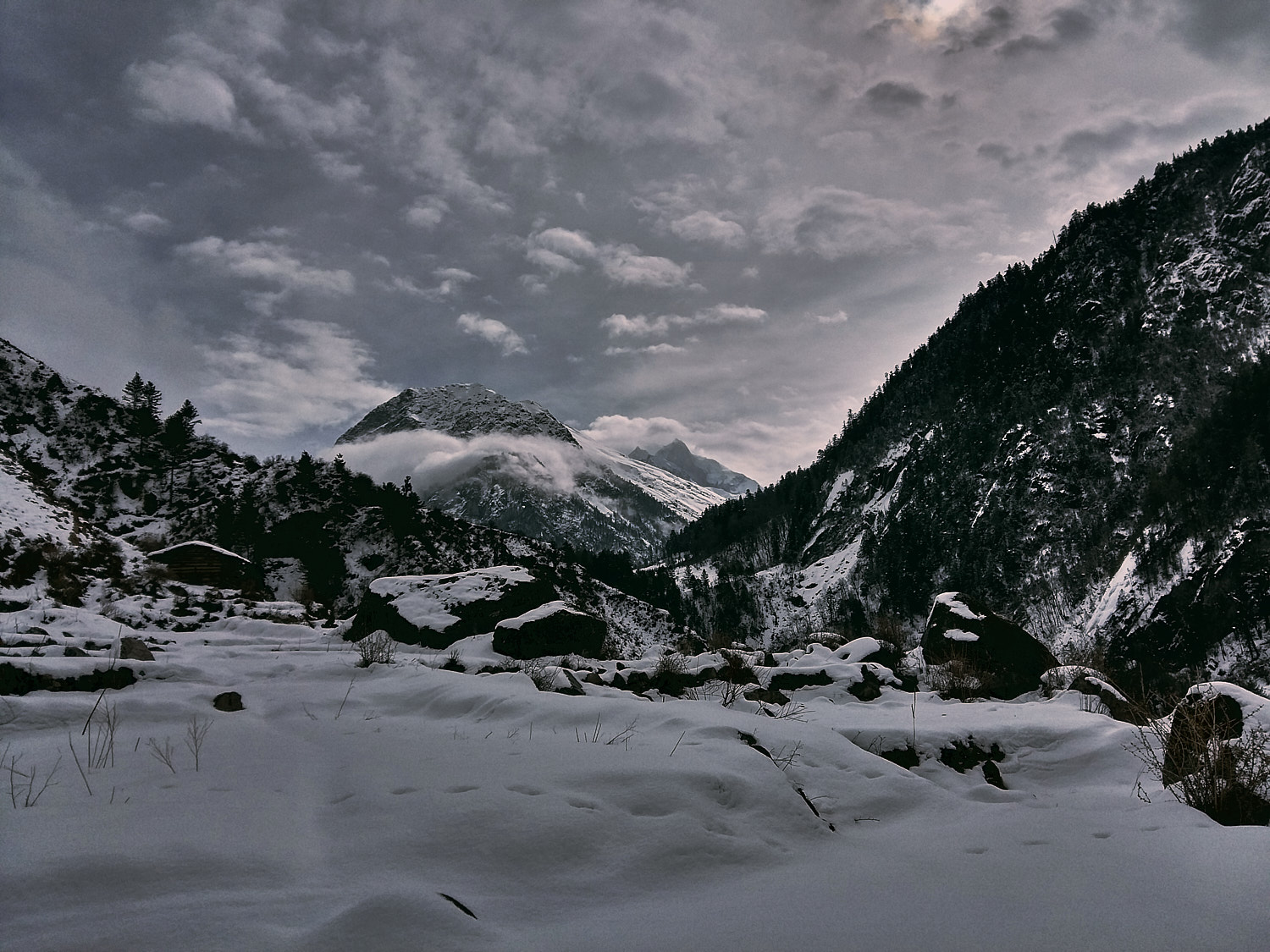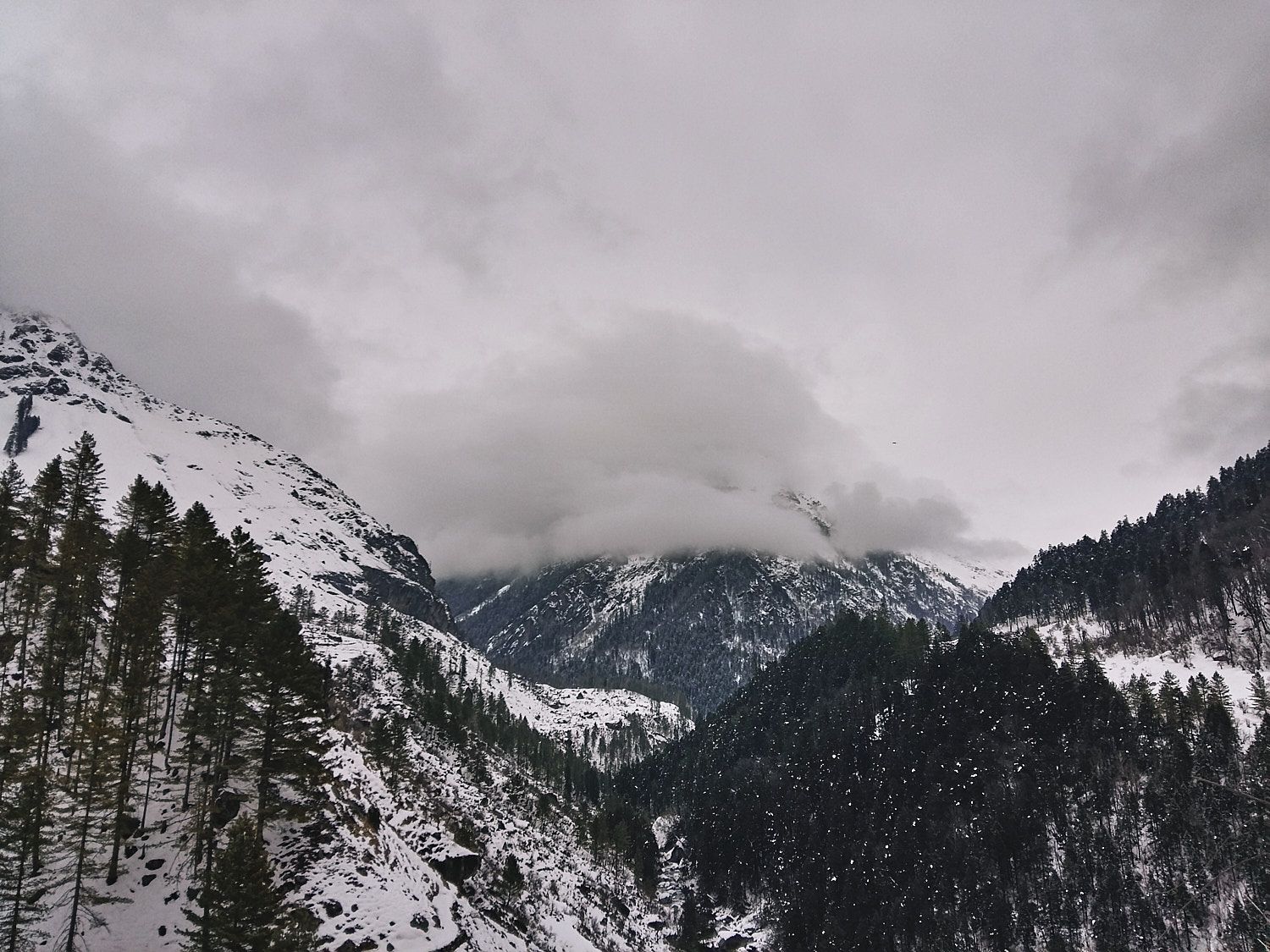
Har Ki Dun trek diary part 3 of 3
“Such ventures required a more hairbreadth creativity: a finer balance between hazard and endurance; talent and vision; a willingness to accept that control may only be an illusion, that success is determined not by the summit, but by the means alone and that at times your survival, may be the only reward. ” — Voytek Kurtyka (Wojciech Kurtyka)
If you haven’t already, I suggest going through [Part 1] and [Part 2] first.
I am GPS locking onto satellites when I wake up. When you sleep in a different location every night it takes a while before your mind registers where you are. I unzip the door to my tent to see if my prayers have been answered. No! It is more cloudy than it was yesterday and the wind has died down too. No wind is not a good sign. I sit in my sleeping bag for a while reverently hoping against hope that the wind will pick up and blow the clouds away, but no such luck. A white pall of invisible lethargy and ennui has fallen over our camp. Dinesh is awake as well by now and he is awfully quiet. Breakfast is a subdued affair. Bread with peanut butter with some leftover chapattis. It starts to snow by the time we’ve finished up packing. Our socks are not completely dry, which means that today we will be starting our day in wet socks. Not a pleasant prospect in the -7°C. My instincts tell me this bad weather will stretch for a few days. I make a decision and then tell a morose looking Dinesh
“Let’s see how far we can get till 12 PM and then let’s head back to Osla.”
The moment I utter these words Dinesh breaks into a bright smile. It is almost as a heavy shroud that was weighing us down has been lifted.

Once we start moving it is obvious to me that 12 is probably an unrealistic estimate. The snow starts to fall in droves now and the snowdrifts get bigger. The trudge starts again, head down a foot in front of the other. Everything is covered in snow and finding the trail becomes a bit of a challenge. The only time I realise I’m off trail is when I sink thigh-deep in snow. The Decathlon boots perform admirably, yet they are way out of their comfort zone by now. Postholing thigh deep at times, I would kill for my pair of MSR Lightning Ascent snowshoes that are gathering dust in the US.
“Correct gear that corresponds to the weather conditions is invaluable. It is true that the right gear is incomplete without the right technique. Yet all the right technique in the world cannot conjure the right gear out of thin air.”
We finish the climb to Kalkatiyadhar (3000m+) but the price we pay is completely drenched socks — main, reserve and the sleeping pair. Har Ki Dun Valley is another 5 kilometres from where we stand but with this freezing weather, it is 5 kilometres too far. Standing on the ridge top, Dinesh & I look at each other and then we break into hysteric laughter. Sometimes nature beats you down and there’s no shame in admitting defeat. It was a valiant effort but it was probably 20 days too early. Har Ki Dun is not going anywhere and I promise myself I will return. Only this time I will not underestimate the snow and I will be better prepared with the right gear. We share a high five, take a few photographs and turn our back into the rising wind to head back to Osla.
Back at Osla we sit in Didi’s cosy kitchen and warm ourselves against the chulha. My feet have started to resemble grated turnips by now. An old woman of Jaunsari origin joins us and regales us with stories of old which other people from the village translate for me. Some of these are tales of customs that seem strange to an outsider like me. The presence of polygamy and polyandry in the local traditions, with the rich(er) practising polygamy, while their poor brethren choose to share a wife (polyandry), though the husbands should be brothers. A fact which is often connected to the five Pandava brothers in the Mahabharata, marrying Draupadi, from whom Jaunsaris trace their ethnic origin.
“The Pandavas and Kauravas figure in the anthropology of the Tons Valley and some families claim to be direct descendants of the two clans. The Jaunsaris claim to be descendants of the Pandavas, while the Bawaris are from the Kauravas or Duryodhana’s clan.”
The kitchen is a warm cosy place, I doze off listening to the stories, wake up for food and to play with a pup who is also invited in the kitchen because of the raging storm. The pup snuggles next to me warming my feet as I become invisible – watching the people drift in and out of the kitchen. Watching a slice of life that is uninterrupted by television, mobiles, the internet or even electricity. A simpler life where children can walk into any kitchen in the village and expect to be fed. A life where things go slow and community living is still prevalent and alive. I wouldn’t go so far as to call it idyllic, but yes it beats living in the city.
So ends my winter/spring attempt to trek to Har Ki Dun. I didn’t do well enough to get a “certificate of completion”. Yet the more I ponder over the definition of “success”, the more I think success is defined by -
- Did I do my best under the circumstances (weather, route conditions, partners)?
- Did I not take any foolish risks?
- Did I return home to my loved ones?
- Did I have fun and experience the challenge I set out to achieve?
When I ponder over these criteria, I do realise that the trek was definitely not a “failure”. It was not a resounding “success” either. Yet, it did put things in perspective for me, humbled me enough, showed me the importance of right gear and put me in the right frame of mind for other treks in Uttarakhand. That is a lot of learning for one trek, don’t you agree?